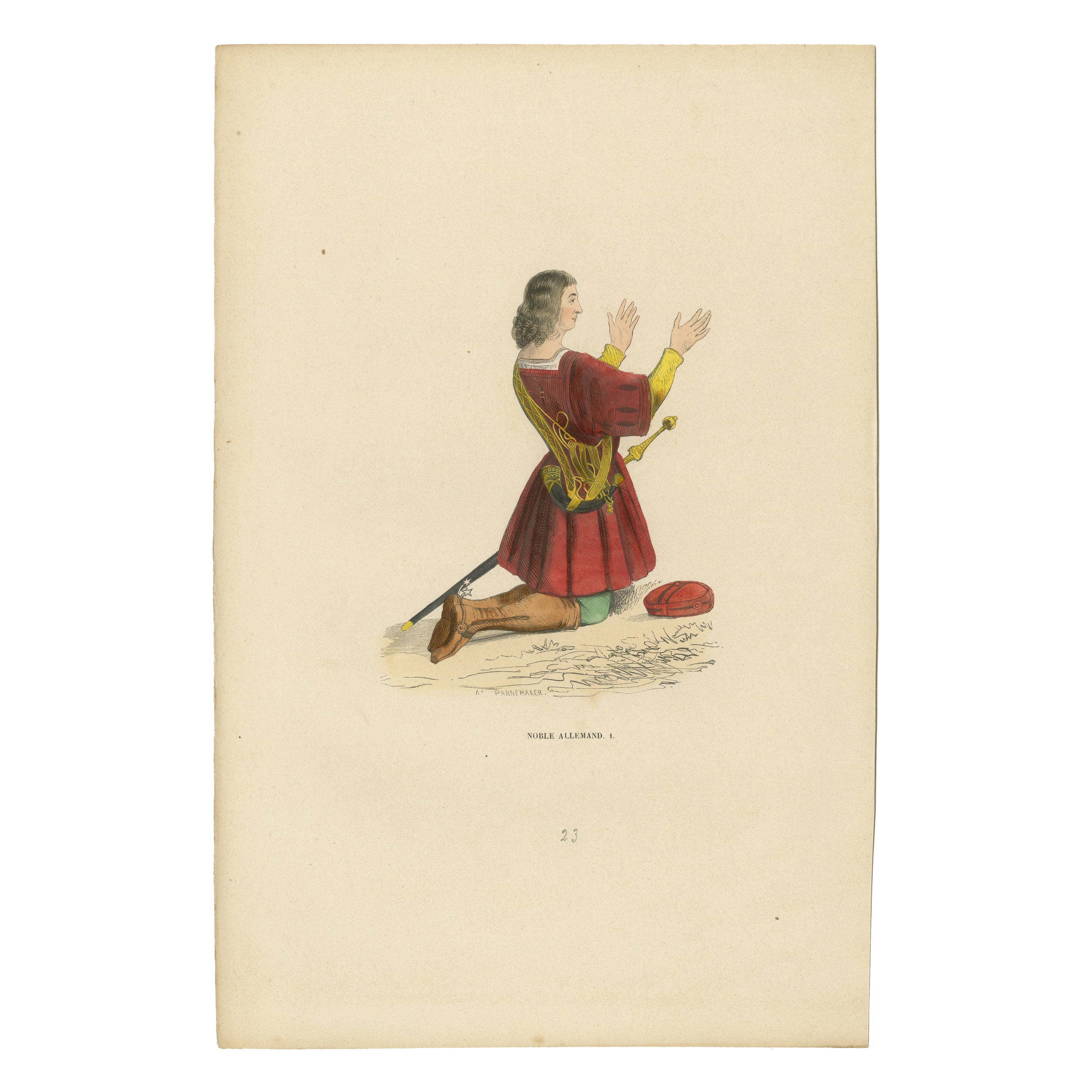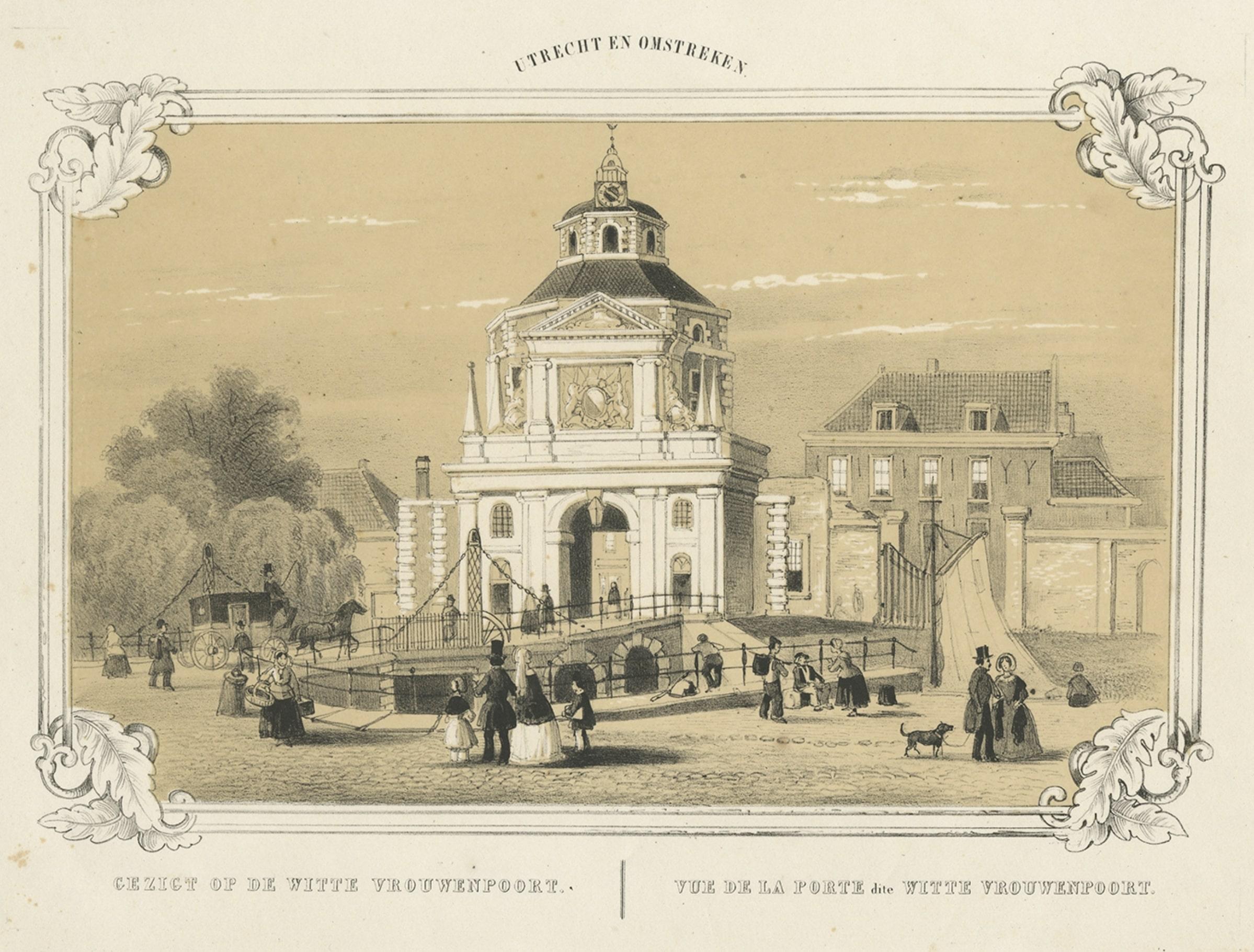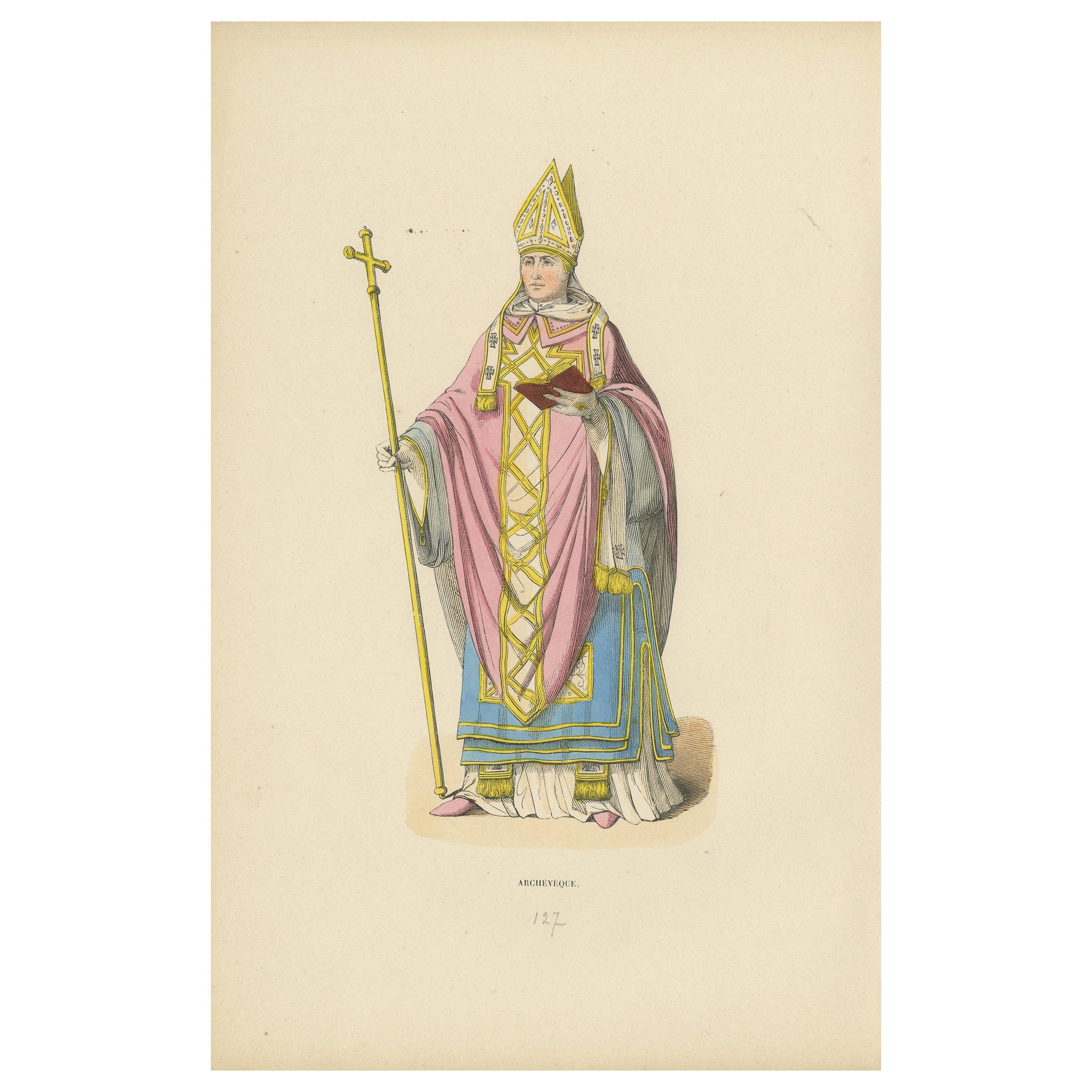Items Similar to Louis the Bavarian in Sepia Tones: Sovereignty Enthroned, 1847
Want more images or videos?
Request additional images or videos from the seller
1 of 6
Louis the Bavarian in Sepia Tones: Sovereignty Enthroned, 1847
About the Item
Title: "Louis the Bavarian: Sovereignty Enthroned"
Description: This sepia-toned print from the "Costume du Moyen Age" series likely dating from 1847, features a figure known as Louis the Bavarian, presumably Louis IV, Holy Roman Emperor, seated in a majestic posture on an ornate throne. The throne itself is adorned with carved figures, possibly lions, symbolizing the power and courage associated with sovereignty.
Louis is depicted in full royal regalia, wearing an elaborate crown that signifies his imperial status. He holds the scepter in his left hand, a traditional symbol of monarchical authority, and in his right, he grasps an orb, another emblem of dominion and his global reach as a ruler. The Emperor's robes are richly detailed with patterns and textures, suggesting opulence and the wealth of his position.
The attire includes a long, flowing cloak and intricately decorated garments underneath, each fold and crease of the fabric rendered with care to emphasize the grandeur of his station. His facial expression is one of stoic command, and his gaze appears fixed on a distant point, possibly reflecting the far-reaching nature of his reign.
The attention to detail in the print, from the embroidery on the robes to the solemnity of the Emperor's demeanor, speaks to the grandiosity and ceremonial importance of such a figure in the medieval hierarchy. This image encapsulates the idea of a monarch as both a political leader and a near-divine figure, central to the era's concepts of governance and law.
- Dimensions:Height: 10.63 in (27 cm)Width: 7.09 in (18 cm)Depth: 0 in (0.02 mm)
- Materials and Techniques:
- Period:
- Date of Manufacture:1847
- Condition:Good. Overal very light toning and light soiling but the image itself clean. Aged paper with typically warm, yellowish-brown hue, mostly around the edges. Study the image carefully.
- Seller Location:Langweer, NL
- Reference Number:
About the Seller
5.0
Platinum Seller
These expertly vetted sellers are 1stDibs' most experienced sellers and are rated highest by our customers.
Established in 2009
1stDibs seller since 2017
1,932 sales on 1stDibs
Typical response time: <1 hour
- ShippingRetrieving quote...Ships From: Langweer, Netherlands
- Return PolicyA return for this item may be initiated within 14 days of delivery.
More From This SellerView All
- Louis XII: The Prudent King in Regal Attire, 1847Located in Langweer, NLThis print presents a dignified portrait of Louis XII, King of France, known for his prudent and just reign. Standing in profile, the king is depicted in royal attire that is both la...Category
Antique 1840s Prints
MaterialsPaper
- The Noble's Plea: A German Aristocrat in Supplication, 1847Located in Langweer, NLThe image depicts a figure labeled as "Noble Allemand," which means "German Noble." The nobleman is shown kneeling on one leg, with his hands raised in what could be a gesture of exc...Category
Antique 1840s Prints
MaterialsPaper
- Old Sepia Print of the Wittevrouwenpoort in Utrecht in The Netherlands, c.1860Located in Langweer, NLAntique print Utrecht titled 'Gezigt op de Witte Vrouwenpoort'. Old tinted lithograph depicting the 'Wittevrouwenpoort' of Utrecht. This print orginates from ' Een Cahier Gezigten va...Category
Antique 19th Century Prints
MaterialsPaper
- Ecclesiastical Splendor: The Archbishop's Regalia in a Lithograph of 1847Located in Langweer, NLTitle: "Ecclesiastical Splendor: The Archbishop's Regalia in 'Costume du Moyen Âge'" Description: This historically rich lithograph from the 1847 edition of "Costume du Moyen Âge" d...Category
Antique 1840s Prints
MaterialsPaper
- Scholar of the Codex: A Medieval Jurist in Study, 1847Located in Langweer, NLThe image depicts a person labeled "Docteur des Lois," which translates to "Doctor of Laws." This term historically refers to an individual who has achieved advanced scholarly status in the field of law, equivalent to the modern term "Juris Doctor." The figure is seated at a lectern, deeply engrossed in a large book, which likely represents legal texts or scholarly works. The individual is attired in a robe with a fur-lined cape, suggesting a status of academic or professional distinction. The robe is red, a color often associated with higher education and learning. The headwear appears to be a type of turban, which was a common academic regalia in certain cultures and times. The setting and attire suggest that this person is a scholar or a high-ranking legal professional, possibly a university professor or a magistrate from the medieval or Renaissance period. Egg whites can be applied as a varnish over pigments to enhance their brightness and to protect the colors. This application could make the colors appear more vivid and also add a slight glossy sheen to the surface of the image. Egg yolk, on the other hand, was commonly used as a binding agent in paint. It forms the basis of tempera paint, a medium that was widely used before the advent of oil painting. Egg yolk helps to create a durable and long-lasting color that adheres well to various surfaces. In the context of the print from 1847, it's less likely that egg whites or yolks were used directly on the print, as by that time, commercial printing processes would have been more advanced and less reliant on such manual methods. However, if this print is a representation of an earlier style or is meant to mimic the appearance of hand-painted...Category
Antique 1840s Prints
MaterialsPaper
- The Common Man's Gesture: A Plebeian in Daily Life, 1847Located in Langweer, NLThis original antique print for sale shows a figure labeled "Plebeien," which is French for "Plebeian," indicating that this individual is a commoner. The person is depicted in a long, bright yellow robe with a hood, which drapes in wide folds to the ground, a style that might have been worn for warmth or work by common people during certain periods in history. The individual is gesturing outward with his right hand, perhaps in conversation or pointing towards something of interest. The expression on his face appears engaged and animated. The simplicity of the robe, despite its vibrant color, suggests practical clothing rather than the more ornate attire of the upper classes. The color could signify a particular role within the community, a trade, or simply be a choice of personal attire. The title suggests the active role of the plebeian within the community and the everyday setting in which he belongs. Egg whites can be applied as a varnish over pigments to enhance their brightness and to protect the colors. This application could make the colors appear more vivid and also add a slight glossy sheen to the surface of the image. Egg yolk, on the other hand, was commonly used as a binding agent in paint. It forms the basis of tempera paint, a medium that was widely used before the advent of oil painting. Egg yolk helps to create a durable and long-lasting color that adheres well to various surfaces. In the context of the print from 1847, it's less likely that egg whites or yolks were used directly on the print, as by that time, commercial printing processes would have been more advanced and less reliant on such manual methods. However, if this print is a representation of an earlier style or is meant to mimic the appearance of hand-painted manuscripts...Category
Antique 1840s Prints
MaterialsPaper
You May Also Like
- Pair of Gilt Framed Classical Engravings in Sepia Tones, Engraved by J. SpieglLocated in Atlanta, GAA pair of Gilt Framed Classical Engravings in Sepia Tones which were engraved by J. Spiegl; from Germany originating in the 18th century.Category
Antique 18th Century German Prints
MaterialsOther
- LUCIEN GOBEIL - 'Sans Titre' - Fine Sepia Tone Etching - Canada - 20th CenturyLocated in Chatham, ONLUCIEN GOBEIL (Canadian - 1935-2017) - 'Sans Titre' - 108/150 - Vintage fine art sepia tone landscape etching on paper - numbered lower left - signed low...Category
Late 20th Century Canadian Post-Modern Prints
MaterialsPaper
- Hiroshige The River ToneBy HiroshigeLocated in Lille, Hauts-de-FranceThis print is an etching by the famous Japanese artist Hiroshige (1797-1858) called "The River Tone". Exact dimensions : 33,5 x 21,5 cm Posthumous print...Category
Antique 1890s Japanese Prints
MaterialsPaper
- Vintage Style Photography, Framed Alpine Ski Photograph, Bavarian GuideLocated in Oxfordshire, GBVintage Style Photography, Framed Alpine Ski Photograph, Bavarian Guide. 'BAVARIAN GUIDE', a modern framed and mounted black and white photograph after an original 1930's skiing pho...Category
Vintage 1930s British Sporting Art Sports Equipment and Memorabilia
MaterialsPaper, Wood
- Alpine Ski Photograph, 'Bavarian Guide' Taken from Original 1930s PhotographLocated in Oxfordshire, GBAlpine Ski Photograph. 'Bavarian Guide', a new mounted black and white photographic image after an original 1930's mountaineering photograph. Black & white alpine photos are the perfect addition to any home or ski lodge, so please do check out our other ski photos...Category
Vintage 1930s British Sporting Art Sports Equipment and Memorabilia
MaterialsPaper
- Original Antique Print of Crocodiles, 1847 'Unframed'Located in St Annes, LancashireGreat image of crocodiles and alligators. Unframed. It gives you the option of perhaps making a set up using your own choice of frames. Lithograph after Cpt. Brown with original ha...Category
Antique 1840s English Folk Art Prints
MaterialsPaper





